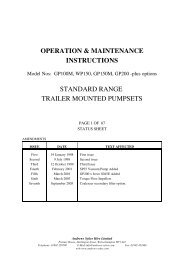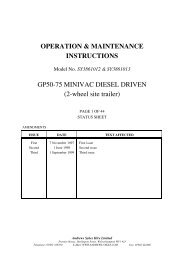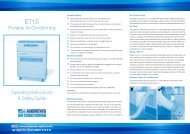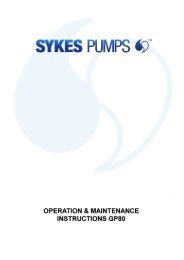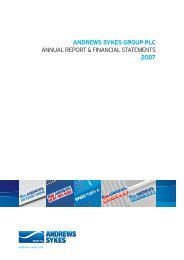Cooling & Heating - Andrews Sykes
Cooling & Heating - Andrews Sykes
Cooling & Heating - Andrews Sykes
Create successful ePaper yourself
Turn your PDF publications into a flip-book with our unique Google optimized e-Paper software.
Dehumidification informationCalculation and selection of thecorrect dehumidifier or dryerTo correctly decide upon the most efficientway of drying an area many factors needto be considered: temperature, materials,relative humidity and drying time. Thiscalculation is best left to the expertsat <strong>Andrews</strong> <strong>Sykes</strong> who, armed with ahygrometer and psychrometric chart, willgive you the very best advice – free ofcharge – on how to use our units.Basic ‘rule of thumb’ sizingRefrigerant unitsThese are usually sized taking a typical RHof 75% at an air temperature of 20ºC, theperformance of the unit will vary greatlyas the temperature and RH rises or falls.Typically the units are shown to be able tokeep an area in cubic metres dry, basedon the above conditions. The dry out areais usually around 50% of this as the areais assumed to be already wet and thismoisture needs to be removed.Desiccant unitsIn general a desiccant unit is suitable todehumidify a room with a volume twotimes bigger than the dry air volumeproduced by the dryer. A desiccant dryerwith a dry air volume of 1,600 m³/hr issuitable to dry a room of approximately3,200 m³.Installation of a dehumidifierBefore the installation of a dehumidifier,the room to be dried has to be sealed aswell as possible. This means the room’swindows and doors are kept closed andgaps and ventilation holes are covered sothat humid air is prevented from flowinginside from the outside. Plastic coversare suitable for sealing a room – it is notnecessary to use heat insulation!If one dryer is to be used it should bepositioned in the middle of the room. Forlarger rooms, where more dryers are used,the total room should be divided into asmany equal sections as dryers to be used.A dryer is installed in the middle of eachsection to ensure perfect air circulation.The dryer has to be positioned so it canblow dry air without obstruction, and itsair inlet grill remains clear. If dryers areused in conjunction with heaters (electricalor indirect fired) make sure hot air isnot blown in the direction of the dryers.The condensation from the dryer can becaught in a container or a hose can beused to drain the condensation to outsideor to a drain. In this case the water has tobe piped off vertically otherwise leakageswill occur. Larger <strong>Andrews</strong> <strong>Sykes</strong>' dryersremove condensation by means of acondensation pump - a new developmentin dehumidification technology. This pumpallows the condensation to be easilypumped upwards through a window ordown to an outside drain. Due to this newdevelopment it is no longer necessary toempty and to check the waterbuckets,for example during the weekends andholidays.Faster dryingFor a faster drying process, dryers canbe installed together with <strong>Andrews</strong><strong>Sykes</strong> ventilation fans. The increasedair circulation results in faster moistureevaporation, minimising the danger ofshrink damage from drying out too fast.In some cases the addition of indirect orelectrical heaters may be recommended.84 Click www.andrews-sykes.com





